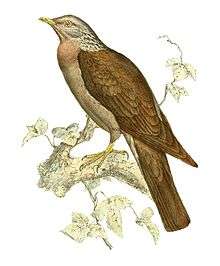Comoros olive pigeon
The Comoros olive pigeon (Columba pollenii), also known as the Comoro olive pigeon,[2] is a species of bird in the family Columbidae. It is found in Comoros and Mayotte. It is becoming rare due to habitat loss.
| Comoros olive pigeon | |
|---|---|
 | |
| Scientific classification | |
| Kingdom: | Animalia |
| Phylum: | Chordata |
| Class: | Aves |
| Order: | Columbiformes |
| Family: | Columbidae |
| Genus: | Columba |
| Species: | C. pollenii |
| Binomial name | |
| Columba pollenii Schlegel, 1866 | |
Description
Easily distinguishable from other pigeon species, the Comoros olive pigeon is the largest bird in the Comoro Islands.[3] It has a dark plumage. Adolescent pigeons have a bright yellow bill, whereas older ones have a dull green or brown bill. The Comoros olive pigeon makes a very deep coo of "guk-ohoooo hoo hooo".[2]
Habitat
Its natural habitat is subtropical or tropical moist montane forests and it can be found in Comoros (especially Mount Karthala) and Mayotte, with a higher-density population being observed in the latter.[2]
Status
Although described as locally common in parts of Grand Comoro, the Comoros olive pigeon is in general a fairly scarce bird with a small total population. The chief threat it faces is the clearance of the forest habitat in which it lives, but it is also hunted on each of the four islands on which it is found. The population trend is unknown, but the total population is probably fewer than 10,000 individuals, and the International Union for Conservation of Nature has assessed its conservation status as "near threatened".[1]
References
- BirdLife International (2012). "Columba pollenii". IUCN Red List of Threatened Species. 2012. Retrieved 26 November 2013.CS1 maint: ref=harv (link)
- Roger Safford; Adrian Skerrett; Frank Hawkins (12 December 2019). Birds of Madagascar and the Indian Ocean Islands. Bloomsbury Publishing. p. 198. ISBN 978-1-4729-7901-8.
- John Coffey Sinclair; Ian Sinclair; Olivier Langrand (1998). Birds of the Indian Ocean Islands. Penguin Random House South Africa. p. 102. ISBN 978-1-86872-035-4.
